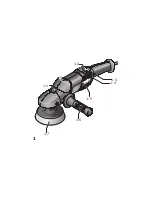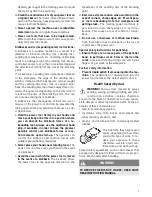
9
dentally get caught in the rotating power tool and
the tool may drill into your body.
m.
Clean the ventilation slots of your power tool on
a regular basis.
The motor-driven blower draws
dust into the housing, heavy deposits of swarf can
cause electrical hazards.
n.
Never operate the machine near combustible
materials.
Sparks can ignite these materials.
o.
Never use tools that have to be liquid-cooled.
Water and other liquid coolants can cause poten-
tially fatal electric shocks.
Kickbacks and corresponding safety instructions:
A kickback is a sudden reaction as a result of a
jammed or blocked rotating tool, sanding disc,
sanding pad, wire brush, etc. Jamming or blocking
leads to an abrupt stop of the rotating tool. An un-
controlled power tool is thus accelerated against
the direction of rotation of the tool at the blocking
point.
If, for example, a sanding disc is jammed or blocked
in the workpiece, the edge of the sanding disc,
which is immersed in the workpiece, can get caught
and the sanding disc may crack or cause a kick-
back. The sanding disc then moves away from or to-
wards the operator, depending on the direction of
rotation of the disc at the blocking point. This can
also cause sanding discs to break.
A kickback is the consequence of incorrect use or
misuse of the power tool and can be prevented by
taking appropriate precautionary measures, as de-
scribed below.
a.
Hold the power tool firmly in your hands and
move your body and arms into a position where
you can absorb the kickback forces of a re-
bounding tool. Always use the additional hand
grip, if available, in order to have the greatest
possible control over kickback forces or reac-
tion moments upon start-up.
The operator can
control the kickback and reaction forces with
suitable precautionary measures.
b.
Never place your hands near rotating tools.
The
power tool can move over your hand in the event
of a kickback.
c.
Avoid the area in which the power tool is moved
in the event of a kickback.
The kickback drives
the power tool in the opposite direction to the
movement of the sanding disc at the blocking
point.
d.
Exercise extreme caution when working in the
area of corners, sharp edges, etc. Prevent pow-
er tools rebounding from the workpiece and
getting stuck.
The rotating power tool tends to
get stuck at corners, sharp edges, etc., or if it re-
bounds. This causes a loss of control or a kick-
back.
e.
Do not use a chainsaw or toothed saw blade.
Such tools often cause a kickback or the loss of
control over the power tool.
Special safety instructions for polishing
a.
Ensure there are no loose parts of the polisher
hood, in particular cords. Stow or shorten the
cords.
Loose and rotating strings can catch your
fingers or get stuck at the workpiece.
Further safety information
–
Prevent liquid polish from seeping into the ma-
chine.
The penetration of liquid polish into the
power tool increases the risk of electric shock.
Health hazard by dust
WARNING!
Various dust created by power
sanding, sawing, grinding, drilling and other
construction activities contains chemicals
known (to the State of California) to cause cancer,
birth defects or other reproductive harm. Some ex-
amples of these chemicals are:
• lead from lead-based paints,
• crystalline silica from bricks and cement and
other masonry products, and
• arsenic and chromium from chemically treated
lumber.
The risk from these exposures
varies, depending on how often
you do this type of work. To re-
duce your exposure to these
chemicals: work in a well ven-
tilated area, and work with ap-
proved safety equipment, such as dust masks that
are specially designed to filter out microscopic par-
ticles. Wash hands after handling.
WARNING
TO REDUCE THE RISK OF INJURY, USER MUST
READ INSTRUCTION MANUAL.




























